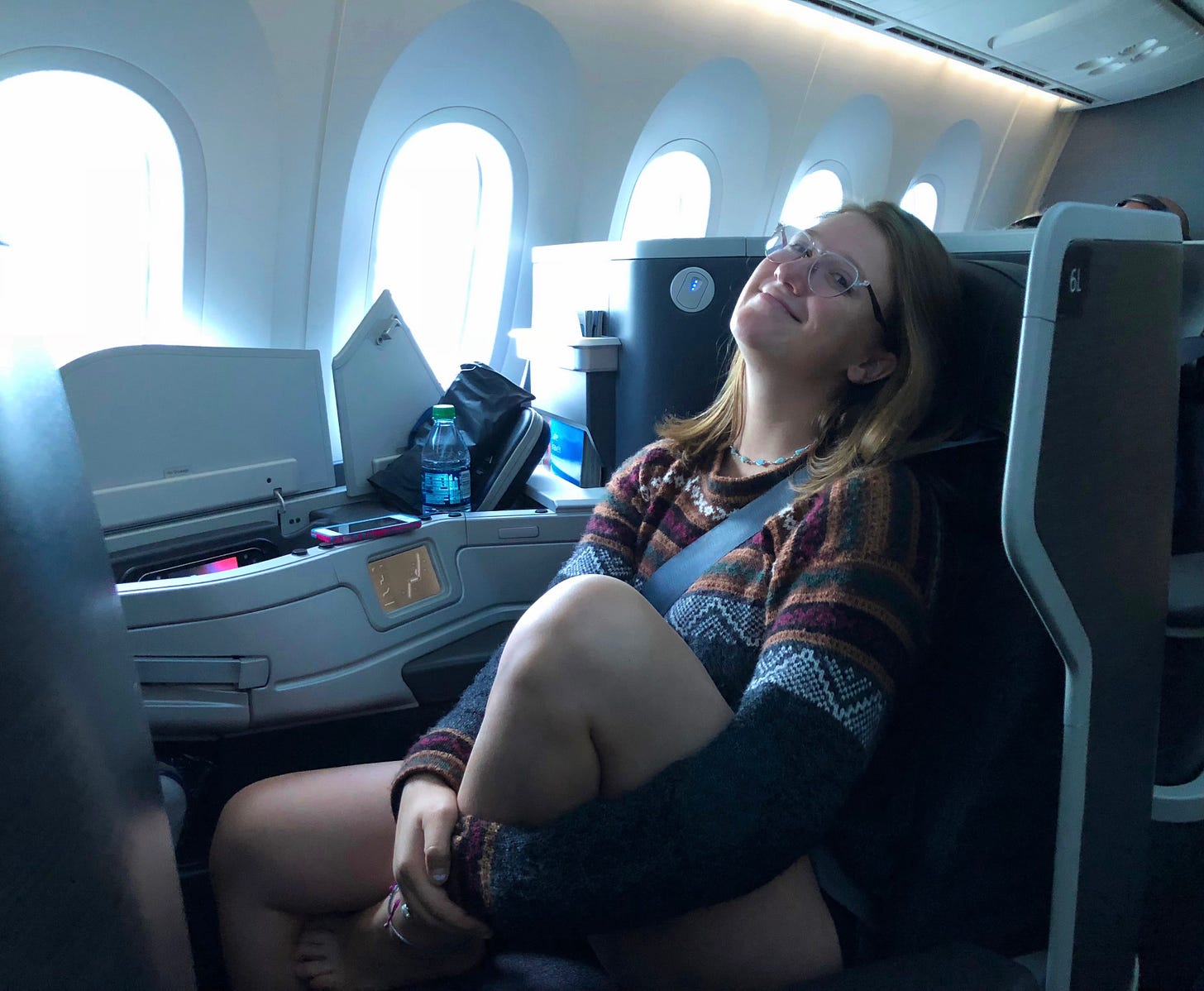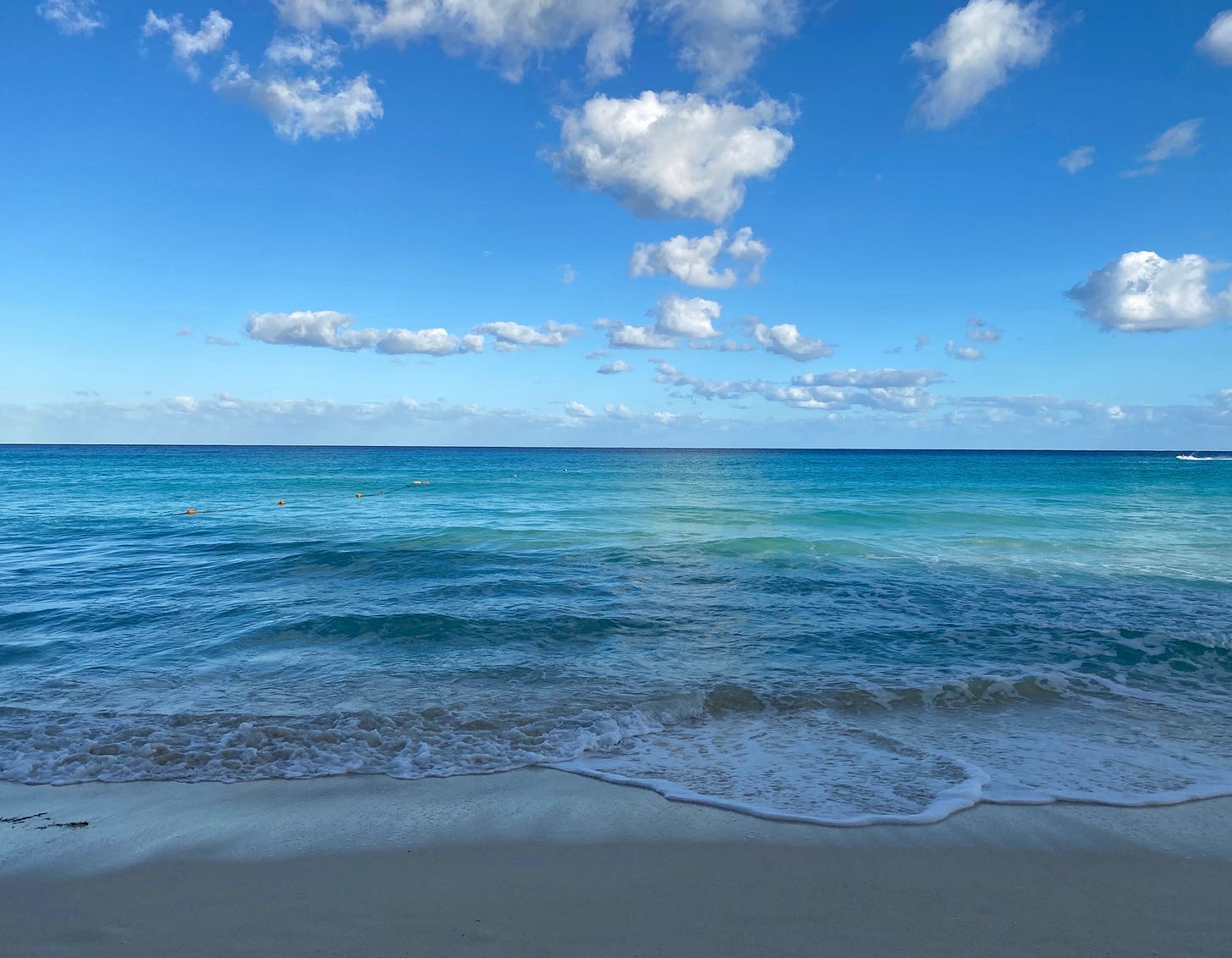In a nutshell, “miles hacking” (also known as “travel hacking”) involves opening up credit cards to get signup bonuses (in the form of frequent flyer miles) and redeeming the miles for free flights. You’ve probably seen the offers in your mailbox and on the internet—“sign up for the United Explorer card and get 50,000 miles!”
A big controversy among miles hackers is whether it’s better to use more miles for luxurious flights that you couldn’t afford otherwise, such as international business or first class, or whether you should use your miles for roughly twice as many coach flights to travel more often but less luxuriously. The sides seem to be split about 50-50, but I’m definitely team luxury. Since I started miles hacking about 15 years ago, my family has flown flat-bed business class to many great cities in Europe, as well as to Australia, Easter Island, Bora Bora, Iceland, and Patagonia, all for the price of taxes.
Here’s an example of how it works
A few years ago, my wife and I opened up 3 Alaska airlines cards (annual fees ranged from $49 to $99) and with the signup bonuses, we earned enough Alaska miles to redeem them for 3 business class flights to Australia on Fiji Airways, a redemption worth over $15,000 (the cash price of the 3 tickets). The lie flat seats, airport lounges, pajamas/pillow/blanket, and great food, wine, and hot fudge cart (!) made the 15 hours of flying time SO much more enjoyable. Warning: once you fly business class on long-haul flights, it’s hard to go back to coach! (Fortunately for us, with miles hacking, we’ve never had to).
We also travel 2-3x more often than we did before I started this hobby, thanks to having the Southwest Companion Pass for 8 consecutive years. The SW CP is the gold standard of miles hacking and often the first target for newbie miles hackers. You can google “how to get the SW Companion Pass” to learn the ins and outs, but the tldr is that once you earn the CP (usually by opening 1 personal and 1 business Southwest card), your companion flies with you for “free” (just the prices of taxes, about $5.60 domestically) for the rest of that year AND the entire next calendar year. We use our CP for about 10-15 flights per year, saving an average of $3-4k annually. Southwest not only has a great domestic route network, but they fly to many awesome places in the Caribbean, including Mexico, Costa Rica, Jamaica, Puerto Rico, the Dominican Republic, Turks and Caicos, Aruba, Grand Cayman, and the Bahamas.
Miles hacking also comes in handy when you’re in a jam and need to buy a same-day flight because of an emergency or flight cancellation. For example, we were at the Southern tip of Chile in Patagonia when the Covid pandemic started, and the hotel manager told us that we needed to leave immediately because “Chile is closing.” We had flown on Latam airlines, who has terrible customer service and basically never answered their phone during the pandemic. Luckily for us, we had booked our flights on Latam using Alaska frequent flyer miles, so one call to Alaska was all it took for them to rebook us on an earlier Latam flight home. Another time we had boarded an American airlines flight in Boston and it was uncertain when or if we’d be able to take off (the crew was dealing with a very disruptive passenger). Tired from already having flown in from Europe, I got on my phone while still on the plane and used points to book an airport hotel for the night and a flight home on Southwest the next day, and then we got off the plane, feeling immediately relieved (and fortunate that we had other options).
Who is this hobby for?
Miles hacking is the perfect hobby for me because it combines my love of research, travel, and getting a great deal. However, it’s not for everyone. If you have debt (e.g., from credit cards or college loans), a low credit score (<700), lack a well-paying steady job, or live outside the US (where signup bonuses are hard to come by), it’s probably not for you. Miles hacking is generally best for people who both earn and spend a lot of money each month.
You also have to be VERY disciplined and organized. First, you need to be disciplined not to spend any money that you wouldn’t ordinarily spend (e.g., to meet the “minimum spend” for a credit card bonus, often 2-3k, you should only be shifting your normal spend to credit cards rather than cash, not buying a new TV that you don’t need in order to “get your bonus”). Second, you need to be very organized and stay on top of things (e.g., to make sure you spend enough before the deadline to get the bonus, to make sure you pay off all your credit cards monthly to avoid accruing debt, and to keep track of all of your cards and their benefits). You also have to know which cards to use for what kind of purchases (e.g., one card might be 4 points per dollar for dining, while others are 4x for gas, 3x for groceries, or 5x for airline tickets). Our organization system consists of a spreadsheet with all of our credit card information (date opened, signup bonus, benefits), a web-based program (called “Award Wallet”) that keeps track of all of our points and miles and updates automatically, and labeled credit cards in our wallet (for the best “daily use” cards; the ones we don’t use often are kept in a desk drawer).
If you’re intrigued enough to read on, below are answers to the most common questions I get asked.
What kind of credit cards do you open?
There are 3 main types of miles hacking cards: (1) airline branded cards (e.g., “Southwest Priority” Card), (2) hotel branded cards (e.g., “Marriott Bonvoy” card), and (3) bank cards (e.g., American Express Platinum, Chase Sapphire Reserve) whose flexible points transfer to airlines and hotels (e.g., Chase points transfer to United, Southwest and Hyatt; Amex points transfer to 19 different airlines, including Delta, and 3 different hotels, including Hilton and Marriott).
Diversification is important in order to have maximum flexibility to redeem your points for pretty much any bucket list trip. At any given time, we each have about a million miles spread across American, Southwest, United, Marriott, Chase, Amex, and Citibank.
Is this illegal?
Nope, not at all. The banks basically use credit card signup bonuses to lure customers to open their cards in the hopes that customers will run up debt, earning the banks lots of money. For smart customers who are able to earn credit card signup bonuses without racking up debt, more power to them. Many miles hackers report that their friends or family think they’re doing something shady, but it’s really a matter of not understanding how it all works. But like I said earlier, it’s not for everyone.
Does opening up all these credit cards hurt your credit score?
It could, but doesn’t have to if you do it right. My wife currently has 18 cards open and I have 17, and both of our credit scores are around 850. But be sure to read about this issue before starting the hobby. Here’s a good article from Experian.
Are frequent flyer miles hard to use?
They can be. To get the most out of your miles and points, it’s best to either (a) educate yourself by reading about it online or (b) you can pay a professional “award ticket booker” to buy your tickets. Hotels are pretty easy to book on points, but for airline tickets, I use both strategies--I know enough to book my own redemptions for simpler trips (e.g., to Europe) but for trickier redemptions (Australia, Bora Bora), I think a ticket booker--who has much more expertise than I do and subscribes to expensive “award availability” sites--is well worth the cost (about $150 per ticket) for an amazing business class redemption that I’d never be able to find on my own.
How can I learn more?
It’s super important to have a strategy before you get too far into miles hacking, because there are many rules and nuances you should learn about in advance. For example, Chase bank has a famous “5/24” rule (no approval for new Chase cards if you’ve opened 5 or more personal cards in the past 24 months, from any bank), which means that you often want to start with Chase cards first (if under 5/24) before moving on to other banks’ cards.
My favorite site is 10x travel--I follow them on facebook and learn a lot, but beginners should start with their free miles hacking course (which includes step-by-step guides and video tutorials) on their website. They also have interesting articles, a free “credit card consultation” (which cards to open in which order, based on your desired trips), and an award booking service. Note that I don’t get any kickbacks from 10xTravel; I’m just a follower who likes their site! There are many other sites that explain miles hacking also, so feel free to use Google to have a look around.






Excellent breakdown. I'm on the other side of the 50/50 breakdown. I like to maximize more trips with my points than 1 luxurious, although I question that on the backend of a coach flight.